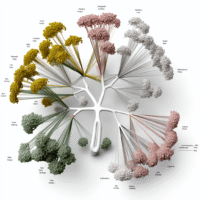AI Lab itinai.com
-
From Black Box to Open Book: How Stanford’s CausalGym is Decoding the Mysteries of Artificial Intelligence AI Language Processing!
Stanford researchers have introduced CausalGym, aiming to unravel the opaque nature of language models (LMs) and understand their language processing mechanisms. This innovative benchmark method, applied to Pythia models, emphasizes causality, revealing discrete stages of learning complex linguistic tasks and showcasing potential to bridge the gap between human cognition and artificial intelligence. ➡️➡️➡️
-
Revolutionizing Content Moderation in Digital Advertising: A Scalable LLM Approach
Google Ads Safety, Google Research, and the University of Washington have developed an innovative content moderation system using large language models. This multi-tiered approach efficiently selects and reviews ads, significantly reducing the volume for detailed analysis. The system’s use of cross-modal similarity representations has led to impressive efficiency and effectiveness, setting a new industry standard. ➡️➡️➡️
-
Meet OmniPred: A Machine Learning Framework to Transform Experimental Design with Universal Regression Models
OmniPred is a revolutionary machine learning framework created by researchers at Google DeepMind and Carnegie Mellon University. It leverages language models to offer superior, versatile metric prediction, overcoming the limitations of traditional regression methods. With multi-task learning and scalability, OmniPred outperforms conventional models, marking a significant advancement in experimental design. ➡️➡️➡️
-
CMU Researchers Introduce Sequoia: A Scalable, Robust, and Hardware-Aware Algorithm for Speculative Decoding
Efficiently supporting large language models (LLMs) is crucial as their use increases. Speculative decoding has been proposed to accelerate LLM inference, addressing limitations of existing tree-based approaches. Researchers from Carnegie Mellon University, Meta AI, Together AI, and Yandex introduce Sequoia, an algorithm for speculative decoding, demonstrating impressive speedups and scalability. Read more on MarkTechPost. ➡️➡️➡️
-
Researchers from Mohamed bin Zayed University of AI Developed ‘PALO’: A Polyglot Large Multimodal Model for 5B People
PALO, a multilingual Large Multimodal Model (LMM) developed by researchers from Mohamed bin Zayed University of AI, can answer questions in ten languages simultaneously. It bridges vision and language understanding across high- and low-resource languages, showcasing scalability and generalization capabilities, enhancing inclusivity and performance in vision-language tasks worldwide. ➡️➡️➡️
-
This Paper from Meta AI Investigates the Radioactivity of LLM-Generated Texts
Recent research on the radioactivity of Large Language Models (LLMs) explores detectability of texts created by LLMs, focusing on reusing machine-generated content in AI model training. New watermarked training data methods outperform conventional techniques, offering a more efficient way of detection for open-model scenarios. Watermarked text contamination and its impact on detecting radioactivity are examined. […] ➡️➡️➡️
-
The University of Calgary Unleashes Game-Changing Structured Sparsity Method: SRigL
Efficiency in neural networks is crucial in AI’s advancement. Structured sparsity offers promise in balancing computational economy and model performance. SRigL, a groundbreaking method by a collaborative team, embraces structured sparsity and demonstrates remarkable computational efficiency. It achieves significant speedups and maintains model performance, marking a leap forward in efficient neural network training. ➡️➡️➡️
-
This AI Paper from Harvard Introduces Q-Probing: A New Frontier in Machine Learning for Adapting Pre-Trained Language Models
Q-Probe, a new method from Harvard, efficiently adapts pre-trained language models for specific tasks. It balances between extensive finetuning and simple prompting, reducing computational overhead while maintaining model adaptability. Showing promise in various domains, it outperforms traditional finetuning methods, particularly in code generation. This advancement enhances the accessibility and utility of language models. ➡️➡️➡️
-
NeuScraper: Pioneering the Future of Web Scraping for Enhanced Large Language Model Pretraining
The quest for clean data for pretraining Large Language Models (LLMs) is formidable amid the cluttered digital realm. Traditional web scrapers struggle to differentiate valuable content, leading to noisy data. NeuScraper, developed by researchers, employs neural network-based web scraping to accurately extract high-quality data, marking a significant leap in LLM pretraining. Full details available in […] ➡️➡️➡️
-
Meet Swin3D++: An Enhanced AI Architecture based on Swin3D for Efficient Pretraining on Multi-Source 3D Point Clouds
The text discusses the challenges of 3D data scarcity and domain differences in point clouds for 3D understanding. It introduces Swin3D++, an architecture addressing these challenges through domain-specific mechanisms and source-augmentation strategy. Swin3D++ outperforms existing methods in 3D tasks and emphasizes the importance of domain-specific parameters for efficient learning. The research contributes to advancements in […] ➡️➡️➡️
-
Meta AI Releases MMCSG: A Dataset with 25h+ of Two-Sided Conversations Captured Using Project Aria
The CHiME-8 MMCSG task addresses the challenge of transcribing smart glasses-recorded natural conversations in real-time, focusing on activities like speaker diarization and speech recognition. By leveraging multi-modal data and advanced signal processing techniques, the MMCSG dataset aims to enhance transcription accuracy and tackle challenges such as noise reduction and speaker identification. ➡️➡️➡️
-
Meet AlphaMonarch-7B: One of the Best-Performing Non-Merge 7B Models on the Open LLM Leaderboard
Developing a new model, AlphaMonarch-7B, aims to strike a balance between conversational fluency and reasoning prowess in artificial intelligence. Its unique fine-tuning process enhances its problem-solving abilities without compromising its conversational skills. This model’s performance on benchmarks showcases its strong multi-turn question handling, making it a versatile tool for various AI applications. ➡️➡️➡️
-
Questioning the Value of Machine Learning Techniques: Is Reinforcement Learning with AI Feedback All It’s Cracked Up to Be? Insights from a Stanford and Toyota Research Institute AI Paper
The study by Stanford University and the Toyota Research Institute challenges the conventional wisdom on refining large language models (LLMs). It questions the necessity of the reinforcement learning (RL) step in the Reinforcement Learning with AI Feedback (RLAIF) paradigm, suggesting that using a strong teacher model for supervised fine-tuning can yield superior or equivalent results […] ➡️➡️➡️
-
Unlocking Speed and Efficiency in Large Language Models with Ouroboros: A Novel Artificial Intelligence Approach to Overcome the Challenges of Speculative Decoding
The Ouroboros framework revolutionizes Large Language Models (LLMs) by addressing their critical limitation of inference speed. It departs from traditional autoregressive methods and offers a speculative decoding approach, accelerating inference without compromising quality. With speedups of up to 2.8x, Ouroboros paves the way for real-time applications, marking a significant leap forward in LLM development. ➡️➡️➡️
-
Meet OpenCodeInterpreter: A Family of Open-Source Code Systems Designed for Generating, Executing, and Iteratively Refining Code
The development of OpenCodeInterpreter represents a significant advancement in automated code generation systems. It seamlessly bridges the gap between code generation and execution by incorporating execution feedback and human insights into the iterative refinement process. This innovation promises to revolutionize software development, offering a dynamic and efficient tool for developers to create complex applications. ➡️➡️➡️
-
Meet TinyLLaVA: The Game-Changer in Machine Learning with Smaller Multimodal Frameworks Outperforming Larger Models
Large multimodal models (LMMs) have the potential to revolutionize machine interaction with human languages and visual information, presenting more intuitive understanding. Current research focuses on autoregressive LLMs and fine-tuning LMMs to enhance their capabilities. TinyLLaVA, a novel framework, utilizes small-scale LLMs for multimodal tasks, outperforming larger models and highlighting the importance of innovative solutions in […] ➡️➡️➡️
-
How Does Machine Learning Scale to New Peaks? This AI Paper from ByteDance Introduces MegaScale: Revolutionizing Large Language Model Training with Over 10,000 GPUs
MegaScale, a collaboration between ByteDance and Peking University, revolutionizes Large Language Model (LLM) training by introducing optimization techniques, parallel transformer blocks, and custom network design to enhance efficiency and stability. With its superior performance in real-world applications, MegaScale signifies a pivotal moment in LLM training, achieving unprecedented model FLOPs utilization. [Words: 50] ➡️➡️➡️
-
SalesForce AI Research Proposed the FlipFlop Experiment as a Machine Learning Framework to Systematically Evaluate the LLM Behavior in Multi-Turn Conversations
A new Salesforce AI Research presents the FlipFlop experiment, evaluating the behavior of LLMs in multi-turn conversations. The experiment found that LLMs display sycophantic behavior, often reversing initial predictions when confronted, leading to a decrease in accuracy. Adjusting LLMs with synthetically-generated FlipFlop conversations can reduce sycophantic behavior. The experiment provides a foundation for creating more […] ➡️➡️➡️
-
Harmonizing Vision and Language: The Advent of Bi-Modal Behavioral Alignment (BBA) in Enhancing Multimodal Reasoning
The integration of domain-specific languages (DSL) into large vision-language models (LVLMs) advances multimodal reasoning capabilities. Traditional methods struggle to harmoniously blend visual and DSL reasoning. The Bi-Modal Behavioral Alignment (BBA) method bridges this gap by prompting LVLMs to generate distinct reasoning chains for each modality and aligning them meticulously. BBA showcases significant performance improvements across […] ➡️➡️➡️
-
Apple Researchers Introduce a Novel Tune Mode: A Game-Changer for Convolution-BatchNorm Blocks in Machine Learning
Deep convolutional neural network training relies on feature normalization to improve stability, reduce internal shifts, and enhance network performance. Convolution-BatchNorm blocks function in train, eval, and deploy modes, with the recent introduction of the Tune mode aiming to bridge the gap between deployment and evaluation, achieving computational efficiency while maintaining stability and performance. ➡️➡️➡️

















